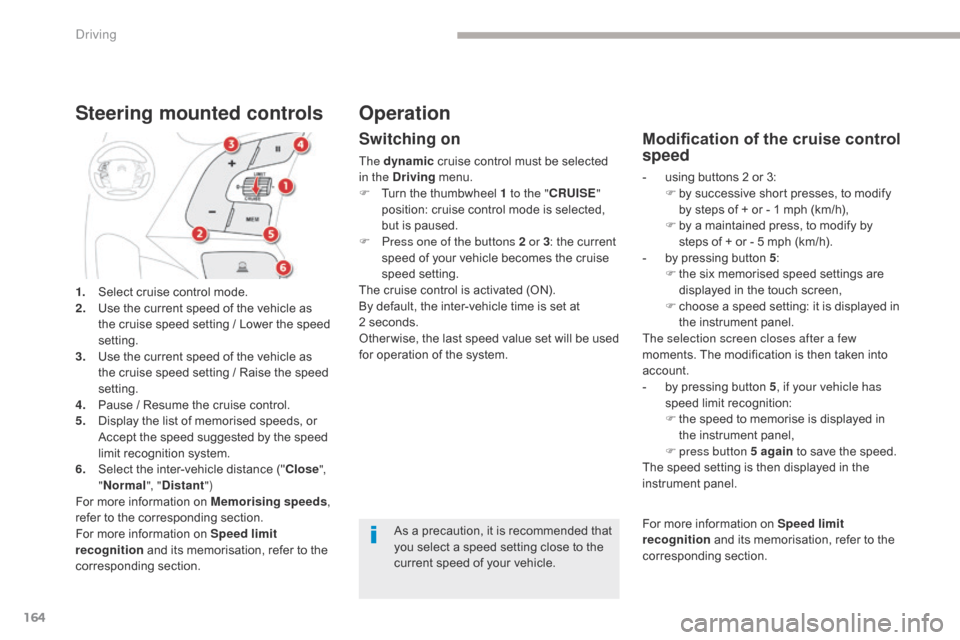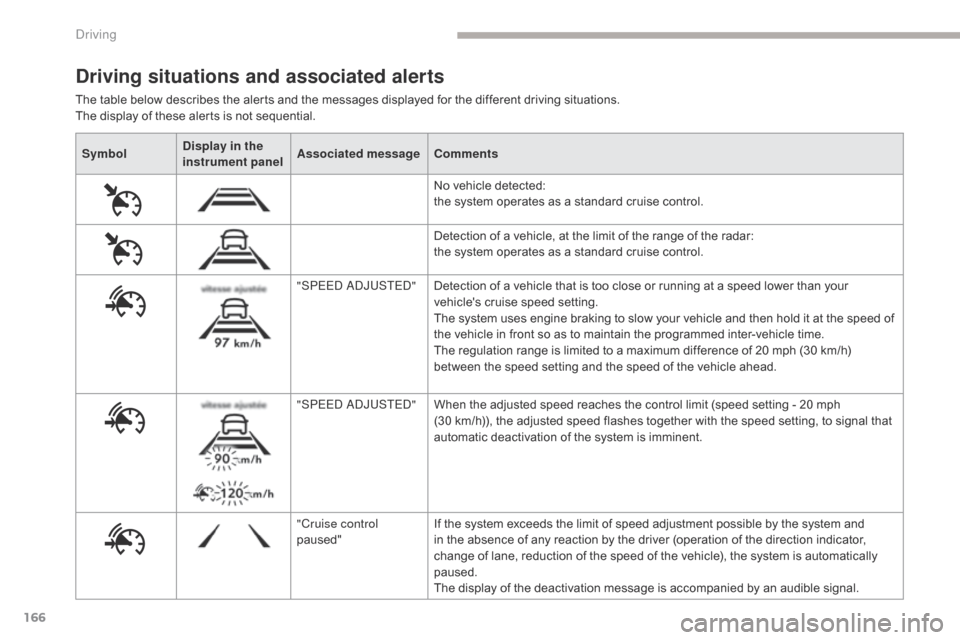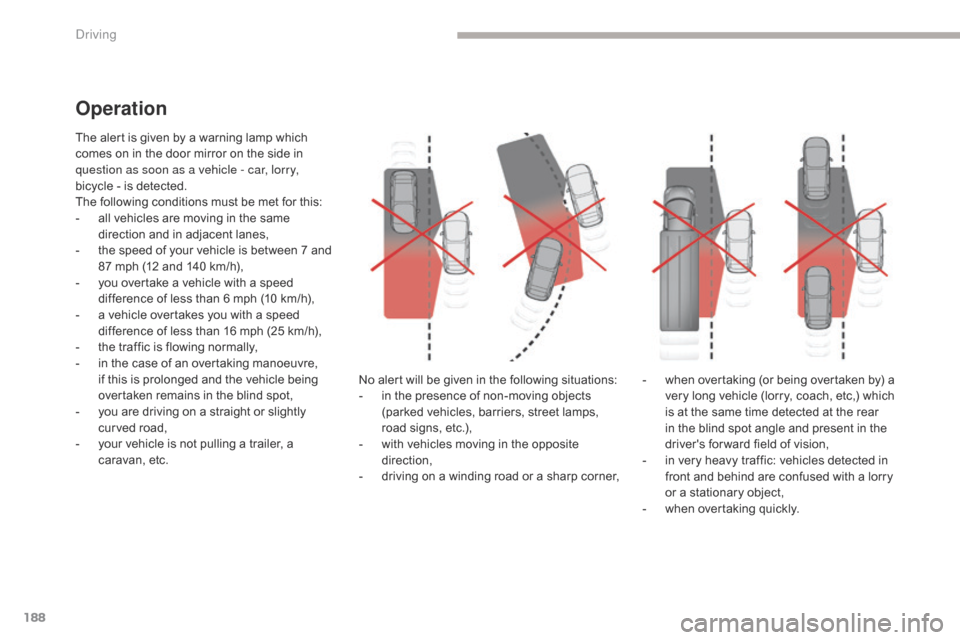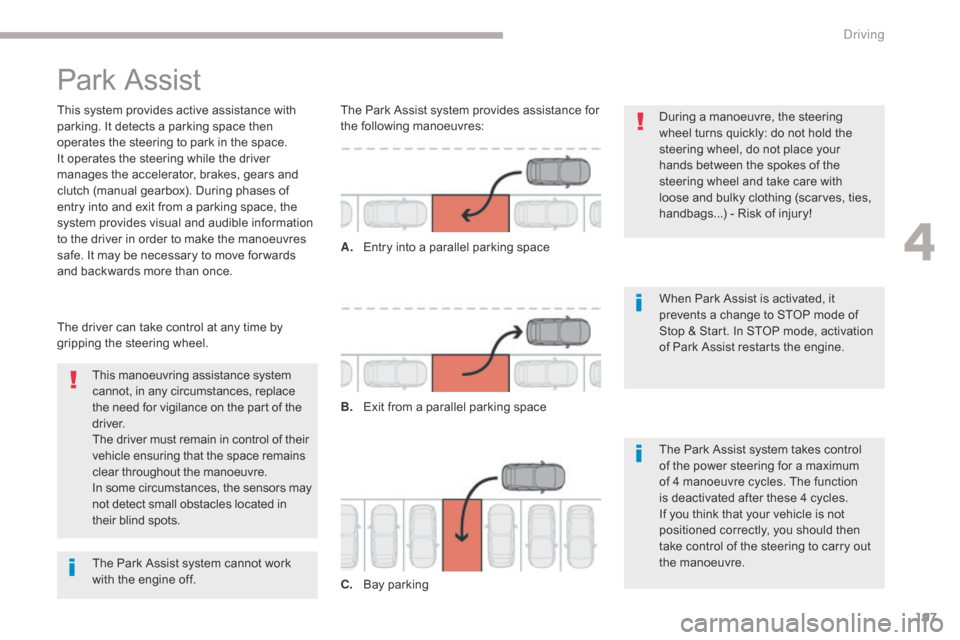Time Citroen GRAND C4 PICASSO 2017 2.G Workshop Manual
[x] Cancel search | Manufacturer: CITROEN, Model Year: 2017, Model line: GRAND C4 PICASSO, Model: Citroen GRAND C4 PICASSO 2017 2.GPages: 527, PDF Size: 12.91 MB
Page 166 of 527

164
C4-Picasso-II_en_Chap04_conduite_ed02-2016
1. Select cruise control mode.
2. Use the current speed of the vehicle as
the cruise speed setting / Lower the speed
setting.
3.
U
se the current speed of the vehicle as
the cruise speed setting / Raise the speed
setting.
4.
P
ause / Resume the cruise control.
5.
D
isplay the list of memorised speeds, or
A
ccept the speed suggested by the speed
limit recognition system.
6.
S
elect the inter-vehicle distance (" Close",
" Normal ", "Distant ")
For more information on Memorising speeds ,
refer to the corresponding section.
For more information on Speed limit
recognition and its memorisation, refer to the
corresponding section.
Steering mounted controls
Switching on
The dynamic cruise control must be selected
in the Driving menu.
F
T
urn the thumbwheel 1 to the " CRUISE"
position: cruise control mode is selected,
but is paused.
F
P
ress one of the buttons 2 or 3 : the current
speed of your vehicle becomes the cruise
speed setting.
The cruise control is activated (ON).
By default, the inter-vehicle time is set at
2
seconds.
Other wise, the last speed value set will be used
for operation of the system.
Modification of the cruise control
speed
- using buttons 2 or 3: F b y successive short presses, to modify
by steps of + or - 1 mph (km/h),
F
b
y a maintained press, to modify by
steps of + or - 5 mph (km/h).
-
b
y pressing button 5 :
F
t
he six memorised speed settings are
displayed in the touch screen,
F
c
hoose a speed setting: it is displayed in
the instrument panel.
The selection screen closes after a few
moments. The modification is then taken into
account.
-
b
y pressing button 5 , if your vehicle has
speed limit recognition:
F
t
he speed to memorise is displayed in
the instrument panel,
F
press button 5 again to save the speed.
The speed setting is then displayed in the
instrument panel.
As a precaution, it is recommended that
you select a speed setting close to the
current speed of your vehicle.
Operation
For more information on Speed limit
recognition and its memorisation, refer to the
corresponding section.
Driving
Page 168 of 527

166
C4-Picasso-II_en_Chap04_conduite_ed02-2016
SymbolDisplay in the
instrument panel Associated message
Comments
No vehicle detected:
the system operates as a standard cruise control.
Detection of a vehicle, at the limit of the range of the radar:
the system operates as a standard cruise control.
"SPEED ADJUSTED" Detection of a vehicle that is too close or running at a speed lower than your
vehicle's cruise speed setting.
The system uses engine braking to slow your vehicle and then hold it at the speed of
the vehicle in front so as to maintain the programmed inter-vehicle time.
The regulation range is limited to a maximum difference of 20 mph (30 km/h)
between the speed setting and the speed of the vehicle ahead.
"SPEED ADJUSTED" When the adjusted speed reaches the control limit (speed setting - 20 mph
(30
km/h)), the adjusted speed flashes together with the speed setting, to signal that
automatic deactivation of the system is imminent.
"Cruise control
paused" If the system exceeds the limit of speed adjustment possible by the system and
in the absence of any reaction by the driver (operation of the direction indicator,
change of lane, reduction of the speed of the vehicle), the system is automatically
paused.
The display of the deactivation message is accompanied by an audible signal.
Driving situations and associated alerts
The table below describes the alerts and the messages displayed for the different driving situations.
The display of these alerts is not sequential.
Driving
Page 171 of 527

169
C4-Picasso-II_en_Chap04_conduite_ed02-2016
Dynamic cruise control with Stop function
The dynamic cruise control is a driving
aid that cannot in any circumstances
replace the observation of speed limits
and safe distances, nor the need for
vigilance on the part of the driver.
It is recommended that you always keep
your feet close to the pedals.
The driver must be ready to take back
control of their vehicle at any time,
using the brake or accelerator pedal as
appropriate.
This system provides two functions:
-
a
utomatic regulation of the speed of the
vehicle to a value programmed by the
driver,
-
a
utomatic adjustment of the distance
between your vehicle and the vehicle
ahead, even to the point of stopping your
vehicle completely.
It manages the acceleration and deceleration
of the vehicle by automatically acting on the
engine and the braking system.
To do this, the system has a radar, located in
the front bumper.
Principles
This system detects a vehicle running in front of
your vehicle, travelling in the same direction.
It automatically adapts the speed of your
vehicle to that of the vehicle in front, to maintain
a constant distance.
If the vehicle in front is running more slowly, the
system slows, or even stops your vehicle, using
engine braking and the braking system.
If the braking system is used to decelerate the
vehicle, the brake lamps come on.
If the vehicle in front accelerates or changes
lane, the cruise control progressively
accelerates your vehicle to return to the
programmed speed.
If the driver operates a direction indicator to
overtake a slower vehicle, the dynamic cruise
control allows your vehicle to temporarily
approach the vehicle in front to assist the
overtaking manoeuvre, though never exceeding
the programmed speed.
4
Driving
Page 181 of 527

179
C4-Picasso-II_en_Chap04_conduite_ed02-2016
Limits of operation
In the following cases, it is recommended
that the system be deactivated in the vehicle
configuration menu:
-
w
hen towing a trailer or caravan,
-
w
hen carrying long objects on roof bars or
a roof rack,
-
b
efore using an automatic car wash, with
the engine running,
-
b
efore placing the vehicle on a rolling road
in a workshop,
-
w
hen the vehicle is being towed, with the
engine running,
-
w
hen a "space-saver" type spare wheel is
fitted (depending on version),
-
f
ollowing impact damage to the windscreen
close to the detection camera,
-
i
f the front bumper has been damaged,
-
i
f the brake lamps are not working.Because of limits in the operation of the
system, it is possible that warnings are
not given, are given too late or seem
unjustified.
Consequently, the driver must always
remain attentive and able to react at any
time to avoid an accident. Where the speed of your vehicle is too
high approaching another vehicle, the
first level of alert may not be displayed:
the level 2 alert may be displayed
di r e c t l y.
Important
: the level 1 alert is never
displayed if the " Close" threshold has
been selected.
Collision Risk Alert
Depending on the degree of risk of collision
detected by the system and the alert threshold
chosen by the driver, different levels of alert can be
triggered and displayed in the instrument panel.
Level 1: visual alert only, signalling
to you that the vehicle in front is very
close.
The message " Vehicle close" is
displayed.
This level of alert is based on the inter-vehicle
time between your vehicle and the vehicle in
front.
Level 2: visual and audible alert,
warning you that a collision is
imminent.
The message " Brake!" is displayed.
This level of alert is based on the time before
collision. It takes account of the vehicle
dynamics, the speed of your vehicle and the
one in front, the environmental conditions, the
operation of the vehicle (cornering, pedals
pressed, etc.) to trigger the alert at the best
moment.
Modifying the alert trigger
threshold
This threshold determines how you wish to be
warned of the presence of a vehicle moving
or stationary in front of you, or a pedestrian
present in your traffic lane.
The current threshold can be modified only via
the Driving menu in the touch screen.
You can select one of three thresholds:
-
"Distant ",
-
"Normal ",
-
"Close ".
The last threshold selected is kept in memory
when the ignition is switched off.
4
Driving
Page 182 of 527

180
C4-Picasso-II_en_Chap04_conduite_ed02-2016
Active Safety Brake
This function, also called automatic emergency
braking, aims to reduce the speed of impact or
avoid a frontal collision by your vehicle where
the driver fails to react.
Using a radar and a camera, this function acts
on the vehicle's braking system.Operation of the function may be felt by
slight vibration in the brake pedal.
If the vehicle comes to a complete stop,
the automatic braking is maintained
for
1 to 2 seconds.
With a manual gearbox, in the event
of the automatic emergency braking
bringing the vehicle to a complete stop,
the engine may stall.
With an automatic gearbox, in the event
of the automatic emergency braking
bringing the vehicle to a complete stop,
keep the brake pedal pressed to stop
the vehicle moving off again.
If the radar and the camera have
confirmed the presence of a vehicle
or a pedestrian, this warning lamp
flashes once the function is acting on
the vehicle's brakes.
Important
: if operation of the
automatic emergency braking is
triggered, you should take back
control of your vehicle and brake
with the pedal to add to or finish the
automatic braking action.
The driver can take back control of the vehicle
at any time by sharply turning the steering
wheel and/or pressing the accelerator pedal.
The triggering of the braking may be
adjusted according to the driver's
driving actions (such as steering wheel
movements, actions on the accelerator
pedal, etc.).
Driving
Page 190 of 527

188
C4-Picasso-II_en_Chap04_conduite_ed02-2016
The alert is given by a warning lamp which
comes on in the door mirror on the side in
question as soon as a vehicle - car, lorry,
bicycle - is detected.
The following conditions must be met for this:
-
a
ll vehicles are moving in the same
direction and in adjacent lanes,
-
t
he speed of your vehicle is between 7 and
87 mph (12 and 140 km/h),
-
y
ou overtake a vehicle with a speed
difference of less than 6 mph (10 km/h),
-
a v
ehicle overtakes you with a speed
difference of less than 16 mph (25 km/h),
-
t
he traffic is flowing normally,
-
i
n the case of an overtaking manoeuvre,
if this is prolonged and the vehicle being
overtaken remains in the blind spot,
-
y
ou are driving on a straight or slightly
curved road,
-
y
our vehicle is not pulling a trailer, a
caravan, etc. No alert will be given in the following situations:
-
i
n the presence of non-moving objects
(parked vehicles, barriers, street lamps,
road signs, etc.),
-
w
ith vehicles moving in the opposite
direction,
-
d
riving on a winding road or a sharp corner,
Operation
- when overtaking (or being overtaken by) a very long vehicle (lorry, coach, etc,) which
is at the same time detected at the rear
in the blind spot angle and present in the
driver's for ward field of vision,
-
i
n very heavy traffic: vehicles detected in
front and behind are confused with a lorry
or a stationary object,
-
w
hen overtaking quickly.
Driving
Page 192 of 527

190
C4-Picasso-II_en_Chap04_conduite_ed02-2016
Fatigue detection system
It is recommended that you take a break as soon as you feel tired or at least every two hours.
Depending on version, the function either has the "Driving time warning" only, or this combined with the "Fatigue detection system".
Driving time warning
The system triggers an alert once it detects that
the driver has not taken a break after two hours
of driving at a speed above 40 mph (65 km/h).
This alert takes the form of the display of a
message encouraging you to take a break,
accompanied by an audible signal.
If the driver does not follow this advice, the
alert is repeated hourly until the vehicle is
stopped.
The system cannot in any
circumstances replace the need for
vigilance on the part of the driver.
Do not take the wheel if you are tired.
As soon as the speed of the vehicle
drops below 40 mph (65 km/h), the
system goes into standby.
The driving time is counted again once
the speed is above 40 mph (65 km/h).
The system resets itself if one of the following
conditions is met:
-
e
ngine running, the vehicle has been
stationary for more than 15 minutes,
-
t
he ignition has been switched off for a
few
m
inutes,
-
t
he driver's seat belt is unfastened and
their door is open.
The system is activated or deactivated in the
touch screen tablet.
Activation / Deactivation
In the Driving
menu, select the " Vehicle
settings " tab, then " Security" and "Fatigue
Detection System ".
Driving
Page 193 of 527

191
C4-Picasso-II_en_Chap04_conduite_ed02-2016
Fatigue detection system
Depending on version, the "Driving time
warning" may be combined with the "Fatigue
detection system".
Using a camera placed at the top of the
windscreen, the system assesses the driver's
level of vigilance by identifying variations in
trajectory compared to the lane markings.
This system is particularly suited to fast roads
(speed higher than 40 mph (65 km/h)).Once the system considers that the behaviour
of the vehicle suggests a certain level of fatigue
or inattention by the driver, it triggers the first
level of alert.
The driver is then alerted by the message
"
Ta k e c a r e ! ", accompanied by an audible
signal.
After three first level alerts, the system triggers
a new alert with the message " Take a break!",
accompanied by a more pronounced audible
signal. In certain driving conditions (poor road
sur face or strong winds), the system
may give alerts independent of the
driver's level of vigilance.
The following situations may inter fere
with the operation of the system or
prevent it working:
-
p
oor visibility (inadequate lighting
of the roadway, falling snow, heavy
rain, dense fog, ...),
- d azzle (headlamps of an oncoming
vehicle, low sun, reflections on
a damp road, leaving a tunnel,
alternating shade and light, ...),
-
w
indscreen area located in front
of the camera: dirty, misted, frost-
covered, snow-covered, damaged
or covered by a sticker,
-
l
ane markings absent, worn,
masked (snow, mud) or multiple
(roadworks, ...),
-
c
lose to the vehicle ahead (lane
markings not detected),
-
r
oads that are narrow, winding, ...
4
Driving
Page 194 of 527

192
C4-Picasso-II_en_Chap04_conduite_ed02-2016
This system indicates the proximity of an
obstacle (e.g. pedestrian, vehicle, tree, gate)
which comes within the field of detection of
sensors located in the bumper.
Certain types of obstacle (e.g. stake,
roadworks cone) detected initially will no longer
be detected at the end of the manoeuvre, if
they are located in blind spots in the sensors'
field of detection.
Parking sensors
This system cannot in any
circumstances replace the need for
vigilance on the part of the driver.The system is switched on by engaging reverse
g e a r.
This is confirmed by an audible signal.
The system is switched off when you come out
of reverse gear.
The proximity information is given by an
intermittent audible signal, the frequency of
which increases as the vehicle approaches the
obstacle.
The sound emitted by the speaker (right-hand
or left-hand) indicates the side on which the
obstacle is located.
When the distance between the vehicle and
the obstacle becomes less than approximately
thirty centimetres, the audible signal becomes
continuous.
Rear parking sensors
This supplements the audible signal by
displaying bars in the screen or the instrument
panel which move progressively nearer to
the vehicle. When the obstacle is near, the
"Danger" symbol is displayed.
Audible assistance
Visual assistance
Driving
Page 199 of 527

197
C4-Picasso-II_en_Chap04_conduite_ed02-2016
Park Assist
This system provides active assistance with
parking. It detects a parking space then
operates the steering to park in the space.
It operates the steering while the driver
manages the accelerator, brakes, gears and
clutch (manual gearbox). During phases of
entry into and exit from a parking space, the
system provides visual and audible information
to the driver in order to make the manoeuvres
safe. It may be necessary to move for wards
and backwards more than once.During a manoeuvre, the steering
wheel turns quickly: do not hold the
steering wheel, do not place your
hands between the spokes of the
steering wheel and take care with
loose and bulky clothing (scarves, ties,
handbags...) - Risk of injury!
When Park Assist is activated, it
prevents a change to STOP mode of
Stop & Start. In STOP mode, activation
of Park Assist restarts the engine.
This manoeuvring assistance system
cannot, in any circumstances, replace
the need for vigilance on the part of the
driver.
The driver must remain in control of their
vehicle ensuring that the space remains
clear throughout the manoeuvre.
In some circumstances, the sensors may
not detect small obstacles located in
their blind spots.
The driver can take control at any time by
gripping the steering wheel. The Park Assist system provides assistance for
the following manoeuvres:
A.
E
ntry into a parallel parking space
B.
E
xit from a parallel parking space
C.
B
ay parkingThe Park Assist system takes control
of the power steering for a maximum
of 4 manoeuvre cycles. The function
is deactivated after these 4 cycles.
If you think that your vehicle is not
positioned correctly, you should then
take control of the steering to carry out
the manoeuvre.
The Park Assist system cannot work
with the engine off.
4
Driving